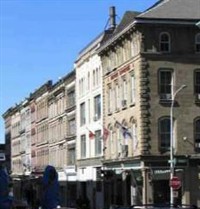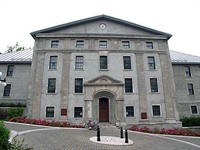Sustainable Development - Protecting our Past and our Future
Published: April 2015
There's always something special about walking down a bustling
urban street and admiring a heritage building, perhaps browsing for
antiques at an old shop, or meeting friends at a pub in a former
19th-century home. Many of the most spectacular
streetscapes in Canada feature a combination of modern and historic
buildings, creating a fusion of old and new. Located in city cores,
historic buildings are key to urban revitalization and renewal, and
to sustainable development. Through the revitalization of old
buildings for new restaurants, shops, offices and residences,
communities can generate income and create trendy, visually and
socially interesting areas. The sustainability and rehabilitation
of historic places is also environmentally responsible.
Sustainable development holds environmental, social, and
economic benefits for everyone. Heritage conservation responds to
these benefits by rehabilitating heritage buildings, a practice
that reduces waste and conserves energy. This approach also
conserves important non-renewable resources. Many Canadian towns
and cities have capitalized on the concept of sustainable
development and have converted heritage buildings into functional
and fashionable districts.
 Granville Block
NHS (left) is a prime example of successful heritage
rehabilitation. Located in downtown Halifax, Nova Scotia, this
complex of 19th-century buildings was an early and
influential demonstration that heritage conservation is a viable
approach to urban planning. Once a busy thoroughfare for commercial
activity in Halifax, Granville Block was rehabilitated in the early
1970s and today houses specialty shops, as well as the Nova Scotia
College of Art and Design, a key partner in the rehabilitation
project.
Granville Block
NHS (left) is a prime example of successful heritage
rehabilitation. Located in downtown Halifax, Nova Scotia, this
complex of 19th-century buildings was an early and
influential demonstration that heritage conservation is a viable
approach to urban planning. Once a busy thoroughfare for commercial
activity in Halifax, Granville Block was rehabilitated in the early
1970s and today houses specialty shops, as well as the Nova Scotia
College of Art and Design, a key partner in the rehabilitation
project.
 Located in Saint John, New Brunswick,
Prince William Streetscape (right) is an important
example of successful heritage conservation. Creating a sense of
time and place through its historic buildings, the Prince William
Streetscape is a rare concentration of homogenous, primarily late
19th-century architecture. Often referred to as "Wall
Street," the district now contains a variety of shops and
businesses while showcasing the work of many Scottish, American,
and Canadian architects.
Located in Saint John, New Brunswick,
Prince William Streetscape (right) is an important
example of successful heritage conservation. Creating a sense of
time and place through its historic buildings, the Prince William
Streetscape is a rare concentration of homogenous, primarily late
19th-century architecture. Often referred to as "Wall
Street," the district now contains a variety of shops and
businesses while showcasing the work of many Scottish, American,
and Canadian architects.
 Historic places can be
conserved and serve entirely new purposes. This process has been
going on for thousands of years. Known as adaptive reuse, this is
an important means by which historic places are conserved.
Morrin College / Former Québec Prison NHS in Quebec
City, for example, served several different purposes throughout its
history. As the Quebec City Common Gaol (1813-1868), the Morrin
College (1862-1902), and the home of the Literary and Historical
Society of Quebec (1824-present), this imposing yet dignified
Neoclassical building was the realization of a heritage building
that preserved a part of Quebec's history, while reflecting how a
place can be transformed over centuries through care and
maintenance.
Historic places can be
conserved and serve entirely new purposes. This process has been
going on for thousands of years. Known as adaptive reuse, this is
an important means by which historic places are conserved.
Morrin College / Former Québec Prison NHS in Quebec
City, for example, served several different purposes throughout its
history. As the Quebec City Common Gaol (1813-1868), the Morrin
College (1862-1902), and the home of the Literary and Historical
Society of Quebec (1824-present), this imposing yet dignified
Neoclassical building was the realization of a heritage building
that preserved a part of Quebec's history, while reflecting how a
place can be transformed over centuries through care and
maintenance.
Despite measures to protect historic places and to promote
sustainability, older buildings are often torn down to make way for
new construction. The concept of "Greenwashing," known as the act
of misleading the public about the environmental benefits of
services, products or practices, is a serious issue when
confronting the rehabilitation of heritage buildings. A tendency to
favour the construction of new buildings over repurposing old ones
under the pretence that newer buildings will be more "green" is
often the least environmentally-friendly option. The sturdy
construction and quality materials of historic places make for
lasting buildings. They are adaptable and durable, and their
conservation reduces waste and energy.
Next time you hear about an historic place being threatened with
demolition to clear space for new construction, consider the
environmental and cultural consequences of the project; things are
not always as they seem! And remember, rehabilitation of historic
places has a lot of advantages, including saving our historic
places for future generations. Sustainable development is a win,
win, win for everyone!